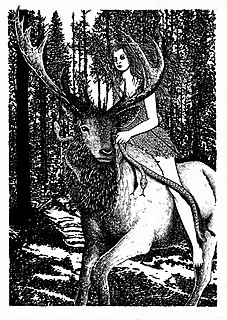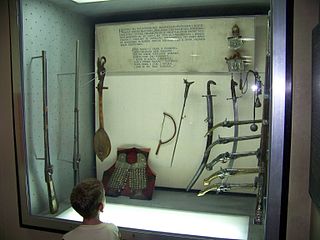 W
WAn ala or hala is a female mythological creature recorded in the folklore of Bulgarians, Macedonians, and Serbs. Ale are considered demons of bad weather whose main purpose is to lead hail-producing thunderclouds in the direction of fields, vineyards, or orchards to destroy the crops, or loot and take them away. Extremely voracious, ale particularly like to eat children, though their gluttony is not limited to Earth. It is believed they sometimes try devouring the Sun or the Moon, causing eclipses, and that it would mean the end of the world should they succeed. When people encounter an ala, their mental or physical health, or even life, are in peril; however, her favor can be gained by approaching her with respect and trust. Being in a good relationship with an ala is very beneficial, because she makes her favorites rich and saves their lives in times of trouble.
 W
WDodola, also known under the names for butterfly: Paparuda, Peperuda, Perperuna or Preperuša, is a pagan tradition found in the Balkans. The central character of the ceremony is usually an orphan girl, less often, a boy. Wearing a skirt made of fresh green knitted vines and small branches, the girl born after the death of her father, the last girl child of the mother, sings and dances through the streets of the village, stopping at every house, where the hosts sprinkle water on her. The ritual is associated with a particular tune to which a particular dance is performed, not only by the girl, but also by the villagers who follow her through the streets, shouting their encouragement.
 W
WSaint George's Day is a Slavic religious holiday, the feast of Saint George celebrated on 23 April by the Julian calendar. In Croatia and Slovenia, the Roman Catholic version of Saint George's Day, Jurjevo is celebrated on 23 April by the Gregorian calendar.
 W
WNational Ensemble of Folk Dances and Songs of Serbia "Kolo", known simply as Ensemble "Kolo", was established on 5 May 1948 by the decision of People's Republic of Serbia which at that time was one of the six constitutional republics of the Federal People's Republic of Yugoslavia. It was established as a professional national ensemble with the aim of collecting, arranging and preserving the general national dance, song and musical treasures. Its first performance was organized 10 days after the establishment in Stanković Musical School in Belgrade. Since its establishment in 1948 until 2012 it had more than 6,000 concerts in front of more than 12 million people.
 W
WA gradobranitelj and an oblačar was, in Serbian tradition, a man who protected his village from destructive weather. In Serbia, bad weather was believed to be brought by various demonic beings, including devils, creatures called ala and aždaja, eagles, black-feathered birds, and the souls of drowned and hanged persons. The gradobranitelj used magic to dissipate hail clouds, and to repel devils and the souls of the drowned and hanged persons, who were thought to bring the clouds. He learned this magic from another gradobranitelj. The oblačar ran to and from beneath a hail cloud, fighting against an aždaja, a serpentine demon which flew in the cloud spewing hail on the fields of the oblačar's village. The gradobranitelj is recorded in north-western Serbia, and the oblačar is recorded in the region of Syrmia. It was also believed in some areas that there were women who could eliminate the danger from destructive weather using sorcery. In other respects, these protectors were normal individuals who lived and worked in their communities as others did.
 W
WThe Kosovo Myth, also known as the Kosovo Cult and the Kosovo Legend, is a Serbian nation-building myth based on legends about events related to the Battle of Kosovo (1389). It has been a subject in Serbian folklore and literary tradition and has been cultivated oral epic poetry and guslar poems. The final form of the legend was not created immediately after the battle but evolved from different originators into various versions. In its modern form it emerged in 19th-century Serbia and served as an important constitutive element of the national identity of modern Serbia and its politics, and in certain periods of other South Slavic nations.
 W
WKukeri are elaborately costumed Bulgarian men, who perform traditional rituals intended to scare away evil spirits. Closely related traditions are found throughout the Balkans and Greece. The costumes cover most of the body and include decorated wooden masks of animals and large bells attached to the belt. Around New Year and before Lent, the kukeri walk and dance through villages to scare away evil spirits with their costumes and the sound of their bells. They are also believed to provide a good harvest, health, and happiness to the village during the year.
 W
WThe Kremna Prophecies or Prophecy from Kremna are a collection of prophecies purporting to have been written before the twentieth-century events that they describe.
 W
WIn Slavic folklore, the raskovnik or razkovniche is a magical herb. According to lore, the raskovnik has the magical property to unlock or uncover anything that is locked or closed. However, legends claim it is notoriously difficult to recognize the herb, and reputedly only certain chthonic animals are able to identify it.
 W
WThe samodiva, samovila or vila, are woodland fairies or nymphs found in South and West Slavic folklore. In Romania, they are known as Iele.
 W
WSerb epic poetry is a form of epic poetry created by Serbs originating in today's Serbia, Bosnia and Herzegovina, Croatia, Montenegro and North Macedonia. The main cycles were composed by unknown Serb authors between the 14th and 19th centuries. They are largely concerned with historical events and personages. The instrument accompanying the epic poetry is the gusle.
 W
WThere are several individuals regarded Serbian folk heroes. Most of them were medieval people, enumerated in Serbian epic poetry. The list includes:
 W
WThe Serbian hajduks were brigands and guerrilla fighters (rebels) throughout Ottoman-held Balkans, organized into bands headed by a harambaša, who descended from the mountains and forests and robbed and attacked the Ottomans. They were often aided by foreign powers, the Republic of Venice and Habsburg Monarchy, during greater conflicts.
 W
WA vampire is a creature from folklore that subsists by feeding on the vital essence of the living. In European folklore, vampires are undead creatures that often visited loved ones and caused mischief or deaths in the neighborhoods they inhabited while they were alive. They wore shrouds and were often described as bloated and of ruddy or dark countenance, markedly different from today's gaunt, pale vampire which dates from the early 19th century.
 W
WA vila is a Slavic fairy similar to a nymph, female, beautiful and with long blonde hair.
 W
WA zduhać and vetrovnjak in Serbian tradition, and a dragon man in Bulgarian, Macedonian and Serbian traditions, were men believed to have an inborn supernatural ability to protect their estate, village, or region against destructive weather conditions, such as storms, hail, or torrential rains. It was believed that the souls of these men could leave their bodies in sleep, to intercept and fight with demonic beings imagined as bringers of bad weather. Having defeated the demons and taken away the stormy clouds they brought, the protectors would return into their bodies and wake up tired.